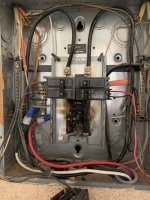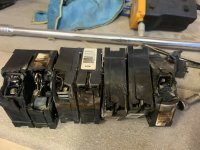I recently installed a Tesla charger on an exterior wall for a customer. I used #6 Copper Thwn -2 90* rating in 1" pvc underground transitioning to emt risers. The run from the sub panel is 35'. The sub-panel is 125 amp. This Tesla charger requires a 240v 60 amp breaker. I wired it as instructed with 2 energized lines, a ground, and properly torqued lugs using the recommended manufacturer breaker for the panel. Within 3 days it completely fried the breakers in the panel. The breakers were smoking, but the 60 amp Tesla breaker had not tripped and was completely melted. The heat from that breaker melted several others. That breaker was brand new. I purchased it the day I installed it. I have read several posts online stating not to install a Tesla charger on anything less than a 150a rated panel, however, Tesla denies this is a problem. I spoke to another electrician here in town and he stated he has had 2 breakers burn up after installing Tesla chargers. I'm in Lake Havasu City, Arizona, so it is not uncommon for temperatures here to be well into 100-125 degrees. I believe the day this burned up it was about 114. I recently swapped out the pane for a 200a using a 125 main. I have been doing some testing. The amp draw is anywhere from 42-28 amps. Breaker temperature is running 127-136 degrees. ANY SUGGESTIONS OR ADVICE?
You are using an out of date browser. It may not display this or other websites correctly.
You should upgrade or use an alternative browser.
You should upgrade or use an alternative browser.
TESLA CHARGER BURNING UP PANEL
- Thread starter jrl5687
- Start date
- Status
- Not open for further replies.
Joethemechanic
Senior Member
- Location
- Hazleton Pa
- Occupation
- Electro-Mechanical Technician. Industrial machinery
I would suspect some kind of pre existing damage/defect to the bus
Thats what I was thinking also. This panel was outside with no deadman cover. Its been exposed for who knows how long. That sounds logical, but now I'm second guessing myself. I have never had anything like this happen in 39 years of doing electrical.
curt swartz
Senior Member
- Location
- San Jose, CA
- Occupation
- Electrical Contractor
I don't know what caused the failure for your project.
I have had to replace a couple panels due to 60 amp PV breakers melting down. Both were Eaton.
I have had to replace a couple panels due to 60 amp PV breakers melting down. Both were Eaton.
MTW
Senior Member
- Location
- SE Michigan
A better thermal conductivity can be had by, using a copper bus panel, bolt on breakers instead of stab on’s, largest loads placed closest to the top of the bus, limiting the loads placed on the individual bus stabs, not placing load breakers opposite each other to allow better heat dissipation. Use larger than required copper conductors to help carry the heat away, spacing breakers apart to allow better airflow, not placing any breaker on the same stab opposite the ones with continuous loads.
I have had this same thing happen in an aluminum bus panel installed in an air conditioned bump shop with spray booths that ran as a continuous load but nowhere near their maximum rating. Following the steps outlined above the replacement panel survived for many years.
Square D QO panels have a copper plated bus, and better stab on clips on the breakers, never has one of them burned up.
Siemens bolt on panels are another good choice for continuous load equipment.
Better equipment costs more but is cheaper than doing the job multiple times.
Make your customer aware and charge them for the better equipment the first time, you both will be happier.
I have had this same thing happen in an aluminum bus panel installed in an air conditioned bump shop with spray booths that ran as a continuous load but nowhere near their maximum rating. Following the steps outlined above the replacement panel survived for many years.
Square D QO panels have a copper plated bus, and better stab on clips on the breakers, never has one of them burned up.
Siemens bolt on panels are another good choice for continuous load equipment.
Better equipment costs more but is cheaper than doing the job multiple times.
Make your customer aware and charge them for the better equipment the first time, you both will be happier.
gadfly56
Senior Member
- Location
- New Jersey
- Occupation
- Professional Engineer, Fire & Life Safety
I thought that was Big Clive before I played the video! Love his stuff, and especially his dead pan salty remarks.Is the breaker a counterfeit?
EV charging is subjecting residential equipment to loads like nothing we’ve seen previously - very high loads for several hours continuously.
All of the UL testing is performed on new equipment. Stuff that’s been in use for any length of time that has experienced enough degradation could end up in thermal runaway.
I don’t know what percentage of EVSE installations end up with catastrophic failures - it’s probably really low - but it’s certainly not unheard of.
All of the UL testing is performed on new equipment. Stuff that’s been in use for any length of time that has experienced enough degradation could end up in thermal runaway.
I don’t know what percentage of EVSE installations end up with catastrophic failures - it’s probably really low - but it’s certainly not unheard of.
Joethemechanic
Senior Member
- Location
- Hazleton Pa
- Occupation
- Electro-Mechanical Technician. Industrial machinery
Yeah that is a pretty large continuous load for a residential panel that has been out in the weather.EV charging is subjecting residential equipment to loads like nothing we’ve seen previously - very high loads for several hours continuously.
Tesla should install some kind of arc fault detection in their cars to protect upstream circuits.. Even if someone is using the 15 amp 120 cord there is always the chance that it could get plugged into a loose receptacle starting a fire
Yeah that is a pretty large continuous load for a residential panel that has been out in the weather.
Tesla should install some kind of arc fault detection in their cars to protect upstream circuits.. Even if someone is using the 15 amp 120 cord there is always the chance that it could get plugged into a loose receptacle starting a fire
Unfortunately, arc fault detection has lost all of its credibility due what’s played out after the device manufacturers forced them into the code long before they were ready for prime time.
Most of these failures I’ve seen pictures of appear to be primarily thermal events - simple joule heating to the point everything melts. By the time arcing starts, the building is likely already on fire.
- Status
- Not open for further replies.



